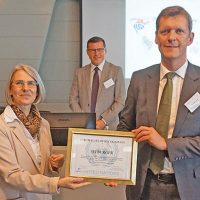Digital Economy and the Maturity of Digitalization

Previous asset-oriented business models are being replaced by new, data-driven concepts geared towards networking. The importance of digital assets in the form of assistants, bots, apps, virtual counterparts and digital twins as well as new virtual realities enriched with additional information is constantly increasing in our everyday lives.
Nevertheless, digitization means much more than just the use of modern information and communication technologies (ICT) as well as Internet technologies. What opportunities and challenges does the digital economy hold for us? And how do you measure the digital maturity of a company?
What is Digital Economy?
When we talk about the digital economy, we are essentially talking about the fact that processes and products based on data, data models and algorithms are increasingly virtualized, people and things are networked, and that knowledge and information are shared. A digital economy is characterized by three features:
- Virtualization
Real existing things are virtually represented as abstract data packets (known as ‘digital twins’ or digital shadows). This allows them to be used simultaneously, repeatedly and independently of location. There are no limits in terms of users, space and time, which opens up completely new design possibilities on the product, service and process level. Virtualization thus functions as an innovation lever and source of added value in the digital economy. - Networking
The networking of people, products and processes creates interacting overall systems based on modern information and Internet technologies. Through networking, the virtualized products and processes can interact and be distributed within the company as well as to customers, suppliers and other external third parties. Networking thus provides the necessary digital infrastructure for the digital economy. - Sharing
Digitization facilitates the exchange and sharing of data, information and knowledge. Because knowledge can be used simultaneously and repeatedly, it becomes a resource in the digital economy that is multiplied by sharing. By linking data both within a company and externally, with suppliers and customers, this knowledge and information exchange also creates new service opportunities. The interest of customers in knowledge about products and services creates new forms of cooperation and collaboration.
Digital Economy: Particularities and Challenges
The digital economy opens up great potential for new business and cooperation models for companies. However, these also involve new requirements:
- Dissemination of Knowledge
The dissemination of knowledge cannot and should not be completely prevented in digital business models. Determining the optimal degree of openness between the drain of knowledge and the controlled use of know-how by third parties is one of the key challenges in digital economies. The API Gateway of the SEEBURGER Business Integration Suite (BIS), for example, can effectively protect and control API data traffic. - Digital Platforms
Transaction, brokerage and development platforms are the infrastructural core of digital economies. The SEEBURGER Business Integration Suite (BIS) is a comprehensive platform for digital change and offers deep integration with all systems, applications, business partners and cloud services. - Collaboration
Digitization opens up new opportunities for collaborative work on knowledge platforms or with shared resources. This often takes place in agile structures with unclear data usage rights and revenue models, or ERP systems are connected with cloud solutions. - Revenue models
Since data are public goods in the digital economy, the realization of revenues is tricky. The current business models solve the problem either by enforcing the exclusion principle (e.g. licenses) or by forms of indirect monetization (paying with data/advertising).
Digitization means the use of widely applicable technologies. In some cases, these lead to a far-reaching, creative destruction of old business models that go beyond industry boundaries, to so-called disruption. One of the most momentous digital disruptions is certainly the gradual displacement of the retail trade by online trading platforms such as Amazon. Music and video streaming services have also had a disruptive effect on the distribution of physical sound and image carriers. The current situation we find ourselves in as a result of the global COVID-19 pandemic is fuelling digital payment transactions and digital banking, and is increasingly displacing cash payments, physical remittance forms and traditional banks.
To meet these challenges quickly and flexibly, agility is a must.
- The higher the degree of maturity of digitization in a company, the more flexibly it can align business models, regulations and IT systems to new requirements.
The Degree of Maturity of Digitization
Even if it may not seem so, digitization is still in its infancy. The potential is far from exhausted. However, the digital transformation is not taking place on its own. It must be actively organized, shaped and driven forward. The degree of digitization and the associated added value at the corporate level can be illustrated very well using a maturity model.
The Four Levels of Maturity of Digitization
Four stages can be used to roughly map the degree of maturity of digitization of companies and administration with regard to the digital transformation. A distinction is made between computerization (stages 1 and 2) and digitization (stages 3 and 4). The ability to map the real world in virtual data models and to establish data-based business models on this basis is decisive for the degree of maturity of a company. Key factors for digital transformation include people’s digital affinity, the degree to which they use the Internet and their skills in dealing with digital applications. A German nationwide company survey, in which 2,500 companies from the industrial and industry-related services sectors took part, revealed the following picture[1]:

Digitization on the process level
According to the study, 10% of the surveyed companies in the industry and industry-related services sector are still at level 0 of digitization. A full 80% of the remaining companies are still at levels 1 and 2 (computerized), and 20% are already at levels 3 and 4 (digitized). The highest level of autonomous computerization is only achieved today by around 2% of the companies surveyed.
Digitization on the product level
Furthermore, the study showed that the share of sales of a product increases significantly with the increasing maturity of a company’s digitization. Companies at levels 3 and 4 generate a good 42% of their revenues with digital services. This is significantly more than twice as much as for companies that can only demonstrate a level 1 or 2 level of digitization maturity.
| Level of Maturity | Percentage of all companies | Digital sales in relation to total sales | Digital added value in relation to the total added value |
| 1 supporting computerized | 54,7 % | 11,8 % | 11,3 % |
| 2 formative computerized | 25,4 % | 17,0 % | 16,1 % |
| 1+2 computerized | 80,1 % | 13,0 % | 12,4 % |
| 3 semi-autonomous digitized | 17,9 % | 43,4 % | 39,4 % |
| 4 autonomous digitized | 2,0 % | 37,5 % | 31,6 % |
| 3+4 digitized | 19,9 % | 42,3 % | 38,0 % |
| Total | 100 % | 15,5 % | 14,6% |
Asked about a forecast for the next five years, the companies surveyed expect the share of digital sales to double. Today, two-thirds of the companies surveyed have already fully achieved or even exceeded the targets set with digitization measures.
To summarize, it can be said that employee growth and sales growth increase with digital maturity.
Digitalized Companies are More Successful
Unleash the enormous potential of digitization with SEEBURGER. We accelerate your business. We are happy to support you in successfully mastering the necessary transformation of your business.
The central, agile, scalable integration platform, the SEEBURGER Business Integration Suite (BIS), connects systems, applications, customers and partners. This ensures that the right data in the right format reaches the right place at the right time – within and between companies. The Business Integration Suite is ‘made by SEEBURGER’ and ‘made in Germany’. It includes B2B, EDI, MFT, EAI and API integration functions that are available in any cloud, hybrid or on-premises. We invite you to find out more about how you can prepare your company for the digital future, so that we can successfully implement it together.
[1] Source: TwinEconomics in vbw, Neue Wertschöpfung durch Digitalisierung, Zukunftsrat der Bayerischen Wirtschaft, Juni 2017
Thank you for your message
We appreciate your interest in SEEBURGER
Get in contact with us:
Please enter details about your project in the message section so we can direct your inquiry to the right consultant.
Written by: Rolf Holicki
Rolf Holicki, Director BU E-Invoicing, SAP&Web Process, is responsible for the SAP/WEB applications and digitization expert. He has more than 25 years of experience in e-invoicing, SAP, Workflow and business process automation. Rolf Holicki has been with SEEBURGER since 2005.





